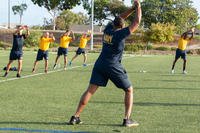When one event hurts you, but a related movement does not, it is difficult to decide whether you should do either. If a bench press does not hurt your elbow but doing a push-up does, should you do either movement?
Here is a recent question asking about running and rucking activity when one hurts more than the other:
Stew, my knees hurt to run, but there is minimal pain when rucking (walking). Been doing physical therapy for months now, and it's helping. Should I still ruck or not? I'm currently a land surveyor, so I walk on average 25 miles a week with a backpack for my job. Thoughts? Be safe. -- Tony
First, it sounds like you are doing the right thing by getting physical therapy. I would ask the physical therapist not only whether you should ruck now, but how you should start back up running again once the therapist releases you from PT.
Second, I would say it is better to be safe than sorry. I'd avoid rucking, if possible, to allow yourself to heal fully. You are putting added stress and weight on your body that you may not yet be 100% ready for, and you could start to hurt while rucking very soon.
Third, take a video of yourself running and rucking. You may be having a hard impact (overstriding, poor running form, need better running shoes, etc.). It could just be a form issue with your running.
We run differently than we walk. I also would get running shoes and rucking boots (especially on uneven terrain). Do not walk in the same shoes you run in. Some people have knee issues due to using the same shoes for both, but you may need special running shoes.
Finally, consider when your knee hurts the most. Is it when walking uphill, downhill or both, or when running on pavement versus running on grass or turf? You may be able to reduce the pain by changing the running surfaces you use.
We mix up our running with dirt, grass, sandy beach and trail runs while trying to limit our pavement running as much as possible, especially in high-mileage running cycles. But when you can get back to running, you should start off with logical progressions: You have to progress gently back into running.
You cannot start off on Day 1 with a five-mile run out of nowhere. Well, you can, but typically this comes with overuse injuries. Remember that one person's workout is someone else's warmup; make sure you build up over time. A good progression is 10% to 15% in time or miles added per week until you get to your goal distance, time, speed, etc.
Do stretch and mobility work daily. You need to stretch often. This can be a mix of static and dynamic stretches, but move your joints around often throughout the day -- especially if you run in the morning and sit the rest of the day. Take a day like my Thursday mobility day each week, too. It can be life-changing.
Given your profession, I would say you are getting enough exercise for above-average health and fitness concerns, and the last thing you want to do is hurt yourself in a way that prevents you from working in your current capacity.
If you can opt out of rucking for a while, it will help you heal quicker. I tend to adjust my mileage (running and rucking) throughout the year, so I am not getting high miles of running each week during the fall and winter, but many more in the spring and summer.
Instead of flatlining my miles per week all year, my mileage looks more like a bell curve, with progressions and peaks in the year. This allows for more joint recovery throughout the year. Any running is replaced with resistance training and non-impact cardio options (bike, rowing, swim, elliptical, etc.). I would consider this approach if that works for your schedule.
Stew Smith is a former Navy SEAL and fitness author certified as a Strength and Conditioning Specialist (CSCS) with the National Strength and Conditioning Association. Visit his Fitness eBook store if you’re looking to start a workout program to create a healthy lifestyle. Send your fitness questions to stew@stewsmith.com.
Want to Learn More About Military Life?
Whether you're thinking of joining the military, looking for fitness and basic training tips, or keeping up with military life and benefits, Military.com has you covered. Subscribe to Military.com to have military news, updates and resources delivered directly to your inbox.

















